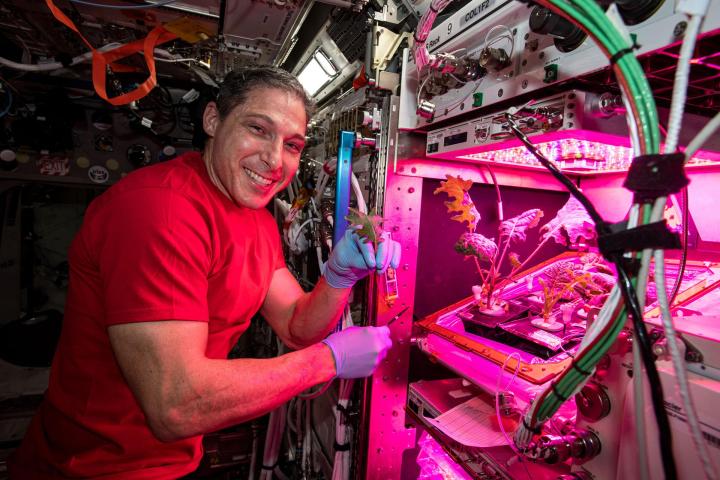
Astronauts on the International Space Station (ISS) are tending to their veggie garden, where they are growing lettuce, radishes, and now mustard greens and pak choi.
NASA astronaut Mike Hopkins has taken a lead role in the care and cultivation of the vegetables being grown on the space station in a number of experiments. He harvested the second crop of radishes grown in space, which the crew ate and enjoyed over the new year. He has also worked on two new experiments, one of which was involved the first transplant of a crop in space. When certain plants are lagging behind in their growth, they are rearranged to make the most of the nutrients available in a delicate procedure.
Another experiment involved the first planting of lettuce seeds in orbit. Normally, seeds are planted into a nutrient medium on the ground before being sent to the ISS. But the development of a new seed film allows the astronauts to plant crops themselves.
Hopkins recently disused the importance of these experiments for long-term space missions, pointing out two reasons they are essential for the future. “First, plants grown in space provide a food source that could enhance astronaut nutrition while making future crews more self-sufficient,” he said in a statement. “Second, these plants are a connection to Earth. The look, feel, taste, and smell all remind us of life on Earth, and that connection is good for our mental health.”
He also mentioned the psychological importance of growing and eating fresh produce. Everything astronauts eat has to be sent in a pre-packaged form which can lead to an effect called food monotony, where people lose their appetites and feel less engaged by food. By contrast, an occasional perk or treat like snacks or fresh vegetables can give a powerful psychological boost. This will be relevant for future missions to Mars, Hopkins said.
“Even though astronauts can’t run to the supermarket for fresh produce during a two-year mission to Mars, they could float into a module that has the same smell and feel of the produce section,” he said. “And that will put a smile on any astronaut’s face, making them more effective during their primary mission activities.”
Another factor to consider in future Mars missions is how long pre-packaged food lasts. With a travel time of at least seven months each way to Mars, future Mars astronauts will need a variety of foods in their diet to sustain them over year-plus missions.
“Pre-packaged food right now has a good shelf life for about 18 months. Even if that diet is extended, there is the psychological component of having fresh food, as well as the interaction with the plants,” said Ralph Fritsche, senior project manager for space production at Kennedy Space Center. “When I look at a system to take to Mars, or to have and deploy on the Moon, this is the kind of thing we want to get to — that capability to continuously supply crops for food.”



